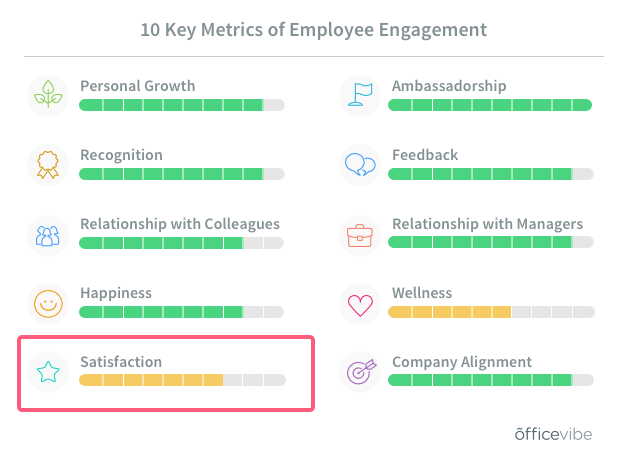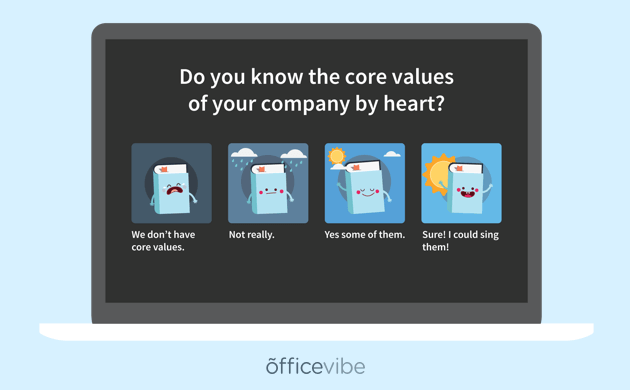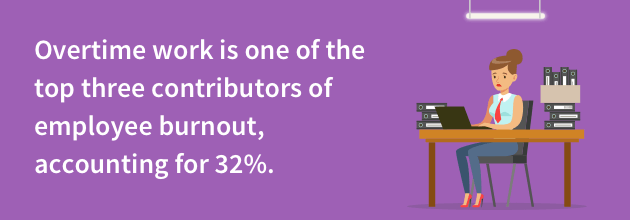There are many ways to understand job satisfaction, and therefore there isn't really one precise or universal definition.
It is this lack of conclusive definition that might be why it’s difficult for managers to get it right. That's why we want to clarify things.
This post will look into the meaning of job satisfaction, how we define it at Officevibe, and the different factors that managers need to pay attention to in order to ensure that employees remain satisfied.
Before we continue...
Job satisfaction definition
On a high level, the Oxford English Dictionary defines job satisfaction as:
A feeling of fulfillment or enjoyment that a person derives from their job.
It’s a broad, all-encompassing view but that is the gist of it. However, we dug a bit deeper to come up with a more comprehensive definition of job satisfaction so that we can measure it (and fix it) properly.
Officevibe’s definition of job satisfaction
Job satisfaction is one of the ten metrics that we measure in Officevibe’s employee engagement software. We’ll explain exactly what we use to measure that metric and how we have come to define the term.

We break down the metric of Job Satisfaction into two main categories, which each have their own subcategories:
- Career- This consists of work environment, workload and clarity of job expectations.
- Compensation- This consists of salary and benefits.
We measure this using our employee engagement software, which prompts employees every week to answer a few simple (and fun) questions about how they’re feeling at work. Keeping a constant pulse on the team and measuring how satisfied they are with their jobs allows managers to fix and solve problems before it leads to the point of employee turnover.
The survey looks something like this:

Factors of job satisfaction
[fancy_list]
[fancy_list_item]
[fancy_list_title]Work Environment[/fancy_list_title]
People are typically affected by their surroundings, and that includes their workspace. The colors of the walls, whether it’s open concept or cubicles, the lighting, etc. Everything from the layout, aesthetic and the mood or vibe that it creates affects how productive and happy your employees are in their place of work.
It turns out that many employees don’t think that their office space is conducive to good work. In an international IPSOS survey, it was found that:
84% of workers reported that their work environment did not allow them to concentrate easily, express ideas freely, work in teams without interruption, or choose where to work based on the task at hand.
The general idea is to look around and see whether your office is inviting and inspiring. If the space is sterile with white walls and gray desks under rows of fluorescent bulbs, you might question how you can spruce up the environment a bit to personalize the space as per your company culture.
For example, at Officevibe, we have game rooms that allow us to take a break and re-energize with some fun.

[callout_attention]Tips to create a postive work environment:
- To elevate the mood and energy of your workplace environment right away, try printing some colorful e motivational quotes to hang up on the walls.
- Buy some plants to put around the office to bring life (literally, with oxygen) to the workspace.
[/callout_attention]
[/fancy_list_item]
[fancy_list_item]
[fancy_list_title]Workload Satisfaction[/fancy_list_title]
If an employee feels overworked, this will undoubtedly affect their job satisfaction.
Unfortunately, many employees across the world are incredibly overworked. Yes, the nature of the workforce is competitive so hard work is required, but it’s important as a manager to do your part in not unnecessarily overworking your employees, or asking more from them than they can manage.

According to Kronos, employees are working more than ever, but overworking leads to burnout, which subsequently lowers job satisfaction and productivity.
In a study published by Stanford University (which you can read about in this Economist article), they found that employee productivity falls sharply after 50 hours, and pretty much stays flat after 55 hours. When they looked at employees that put in 70 hours of work, they found that they produced nothing more than the 55-hour workers.
[callout_attention]Tips to help with workload satisfaction:
- Make sure you have clear boundaries set for work and life, as companies that truly support work-life balance earn the respect of their employees and keep them engaged.
- Avoid reaching out to your team after work hours and on weekends. It’s difficult for employees not to answer, so do your part and don’t reach out when not necessary.
[/callout_attention]
[/fancy_list_item]
[fancy_list_item]
[fancy_list_title]Clarity Of Expectations[/fancy_list_title]
Lack of clarity around an employee’s role is a surprisingly big problem, for new and tenured employees alike. The real problem with a lack of clarity is that it shows a much bigger problem in the organization.
[quote_punchline]It’s impossible for an organization to be successful when there isn’t clear alignment between its objectives and what people spend their time doing.[/quote_punchline]
Ask yourself, have you made it clear to your employees what their role is, what is expected of them, and what actions they must take to accomplish what you expect from them? It seems simple enough, but often we assume that because we know something, or that something is clear to us, it is clear to everyone else around us.
[callout_attention]Tips to clarfiy role and expectations:
- Set Objectives and Key Results (OKRs) with your employees to align them around a shared goal and vision, paving a clear path for them to follow. Repeating and revisiting goals and objectives is the best way to ensure that employees are on the right track.
- Hold frequent one-on-ones with your employees, offering them a safe space to communicate any uncertainties or concerns they have about their role.
[/callout_attention]
[/fancy_list_item]
[fancy_list_item]
[fancy_list_title]Salary[/fancy_list_title]
This is a tricky subject, and it might be out of your control as a manager at the initial hiring stages.
While it’s proven that employees aren’t solely motivated by money, it’s important that they feel fairly compensated for the job they are doing.
Anyone can easily check what the going rate for a job is, so finding out that they are being paid less than market value would be highly aggravating and demotivating, causing low job satisfaction.
You get what you pay for, so if you want to pay a lower rate, you’ll most likely get a lower quality employee or lower quality work.
[callout_attention]Tips to increase salary satisfaction:
- Be sure that you are offering a fair salary according to market value.
- When hiring an employee, ensure that they’re satisfied with the amount that they’re accepting so they don’t harbor any resentment or feel underappreciated.
- Encourage an open dialogue and transparency at all times so employees feel they can discuss everything with you, even something as uncomfortable as salary.
[/callout_attention]
When employees don’t feel fairly recognized, they become unmotivated. This is known as the Equity Theory.
Equity theory is a concept in behavioral psychology that explains how in any relationship, we’re always balancing our input vs the output we get.
When it’s uneven, it affects our mood and satisfaction. This is an even bigger problem in a working relationship, because not only are employees comparing their input vs what they get back from managers, but also among their coworkers.
[/fancy_list_item]
[fancy_list_item]
[fancy_list_title]Benefits[/fancy_list_title]
When salary is something that you can’t change for, benefits are a great way to compensate your employees and keep your team satisfied and engaged. Many of the benefits that you can offer are free and very simple to implement, for instance, the option to work remotely, or flex hours, which recognize work-life balance.
Check out our slideshare with some more great ideas.
[callout_attention]Tips to compensate your employees:
Try offering your employees some of the following perks that will keep them motivated and excited to come to the office everyday:
- Gym membership
- Unlimited vacations
- Lunch delivered to the office
- Health care
- Reimbursement for transportation
- Professional development opportunities
[/callout_attention]
[/fancy_list_item]
[/fancy_list
Equip HR and managers with tools to engage, recognize, and drive performance.




